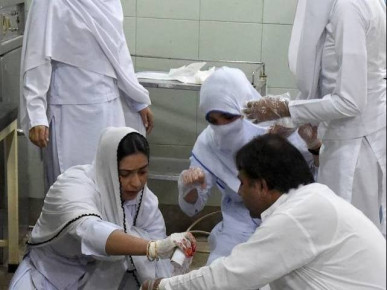
Starting a medical or allied health institute in Pakistan is a challenging yet rewarding endeavor. The country is witnessing a rising demand for skilled healthcare professionals, creating opportunities for new educational institutions to fill the gap. Establishing such an institute requires careful planning, legal compliance, academic affiliation, and a focus on quality education. Whether you want to offer BS programs in Anesthesia, Medical Laboratory Technology (MLT), or Operation Theater Technology (OTT), understanding the step-by-step process is essential.
The first step in starting a medical institute is to define your vision and mission. You need to decide what programs you want to offer, what student demographic you aim to target, and the kind of educational standards you want to maintain. Having a clear vision not only helps in curriculum planning but also plays a significant role when applying for legal registration and university affiliation. A medical or allied health institute must ensure that the programs are designed to meet both national and international healthcare standards. This includes having qualified faculty, well-equipped laboratories, and practical training facilities.
Legal registration is one of the most crucial steps. In Pakistan, a private educational institute can be registered either as a Private Limited Company through the Securities and Exchange Commission of Pakistan (SECP) or as a trust. For most modern institutes offering BS programs, the SECP route is preferred because it allows the institute to operate as a legal entity, enter into contracts, and apply for university affiliations. The name of the institute must be unique, and it is advisable to reserve the name first on the SECP eServices portal. While selecting the name, care must be taken to avoid duplication and restricted words that may require additional justification. Once the name is reserved, the legal entity can be incorporated, and the foundation for the institute is officially set.
After legal registration, the next step is to secure a suitable building. The location of the institute plays a significant role in attracting students and meeting regulatory requirements. The building must meet the criteria for laboratories, classrooms, administrative offices, and library spaces. In Pakistan, using an existing building, such as one previously used for a diploma or allied health program, can reduce startup costs, provided it complies with the standards set by the Higher Education Commission (HEC) and the affiliating university. Leasing is a common option for new institutes, but the lease agreement must allow modifications required for educational purposes, such as installing lab equipment and safety systems.
The academic affiliation is another vital step. For BS programs in medical and allied health fields, affiliation with a recognized university such as the University of Health Sciences (UHS) is essential. Affiliation ensures that your programs are accredited, your students can earn recognized degrees, and your institute adheres to a quality curriculum. The affiliation process typically requires submitting detailed proposals including the academic plan, faculty qualifications, infrastructure details, laboratory facilities, and library resources. It is also necessary to demonstrate compliance with all safety and hygiene regulations. Universities generally send a review team to inspect the facilities before granting affiliation.
Faculty recruitment is equally critical. Qualified and experienced instructors form the backbone of any medical institute. For BS programs, hiring faculty with advanced degrees and practical experience is essential. Institutes often recruit professors, lecturers, and lab instructors from within Pakistan and sometimes internationally to maintain high educational standards. Faculty should also be trained in modern teaching methods, practical demonstrations, and clinical skills. Continuous professional development ensures that students receive the most up-to-date knowledge and skills.
Once the legal and academic frameworks are established, the institute can focus on curriculum design. BS programs in Anesthesia, MLT, and OTT require a balance of theoretical knowledge and practical training. Courses should include classroom lectures, laboratory sessions, clinical exposure, and internships. Collaborating with hospitals and healthcare institutions is beneficial, as it allows students to gain hands-on experience in real medical settings. Curricula should also align with the guidelines set by regulatory bodies and the affiliating university to ensure students meet professional standards upon graduation.
Admission policies are another important area. Clearly defined admission criteria help attract capable students while maintaining academic standards. Entrance tests, interviews, and prior academic records are commonly used to evaluate applicants. Additionally, institutes should establish policies for scholarships, fee structures, and financial aid to make education accessible to a wider range of students. Maintaining transparency in admissions builds trust with parents, students, and regulatory authorities.
Infrastructure plays a pivotal role in delivering quality education. Medical and allied health institutes require specialized laboratories, simulation rooms, operation theater training areas, and fully equipped classrooms. Investing in modern lab equipment, safety devices, and learning resources ensures that students acquire practical skills alongside theoretical knowledge. Libraries should have access to updated medical journals, research papers, and reference books. Institutes may also use online learning platforms to supplement classroom teaching and provide remote access to resources.
Safety and compliance are non-negotiable aspects. Fire safety systems, emergency exits, electrical safety, and hygiene standards must be strictly followed. Regulatory bodies conduct inspections, and failure to comply can delay affiliation or even result in penalties. Institutes should implement strict safety protocols and conduct regular drills to ensure that both staff and students are prepared for emergencies. Safety also extends to laboratory practices, waste disposal, and the handling of medical equipment.
Marketing and outreach are crucial for attracting students and building the institute’s reputation. In the competitive field of healthcare education, institutes must highlight their strengths, such as experienced faculty, modern facilities, practical training opportunities, and recognized affiliations. Using digital marketing, social media, and informative websites helps reach a wider audience. Open houses, career counseling sessions, and partnerships with high schools can also attract prospective students. Reputation is built not just through advertising but also through consistent academic quality, student success, and industry engagement.
Financial planning is equally important. Starting a medical institute requires investment in infrastructure, faculty salaries, equipment, utilities, and marketing. Careful budgeting ensures sustainability while maintaining quality. Institutes often start with one or two BS programs and gradually expand to include more disciplines as they establish credibility and financial stability. Seeking professional advice from accountants or corporate consultants helps in proper financial management and regulatory compliance.
Continuous quality assessment is vital for long-term success. Institutes should implement systems to monitor student performance, faculty effectiveness, curriculum relevance, and infrastructure adequacy. Feedback from students, faculty, and affiliating universities can guide improvements. Accreditation agencies may also conduct periodic reviews, and maintaining high standards ensures that the institute remains competitive and credible in the educational landscape.
Networking with other educational and healthcare organizations enhances the institute’s profile. Collaborative programs, research projects, and student exchange initiatives provide students with broader exposure. Partnerships with hospitals, laboratories, and clinics facilitate internships and employment opportunities. Engaging in professional associations also helps in keeping the institute aligned with national and international trends in healthcare education.
Legal and regulatory compliance continues even after the institute is operational. Annual reporting to SECP, tax compliance, renewal of affiliation, and adherence to labor laws are mandatory. Institutes must maintain proper documentation for inspections and audits. Being proactive in legal and administrative matters prevents future complications and ensures uninterrupted operation.
In conclusion, starting a medical and allied health institute in Pakistan is a multi-step process requiring careful planning, compliance, and commitment to quality education. From defining your vision and legally registering the institute to securing affiliations, hiring qualified faculty, building infrastructure, and ensuring student success, each step is critical. With the rising demand for healthcare professionals, establishing a credible and well-managed institute not only contributes to the development of the sector but also creates opportunities for skilled graduates. By following proper procedures, maintaining high educational standards, and focusing on student outcomes, entrepreneurs can successfully launch and operate a medical or allied health institute in Pakistan, ensuring a lasting impact on the healthcare education landscape.



